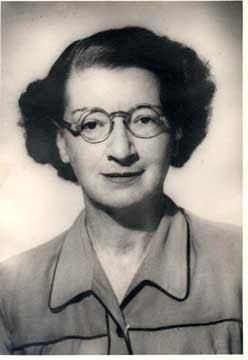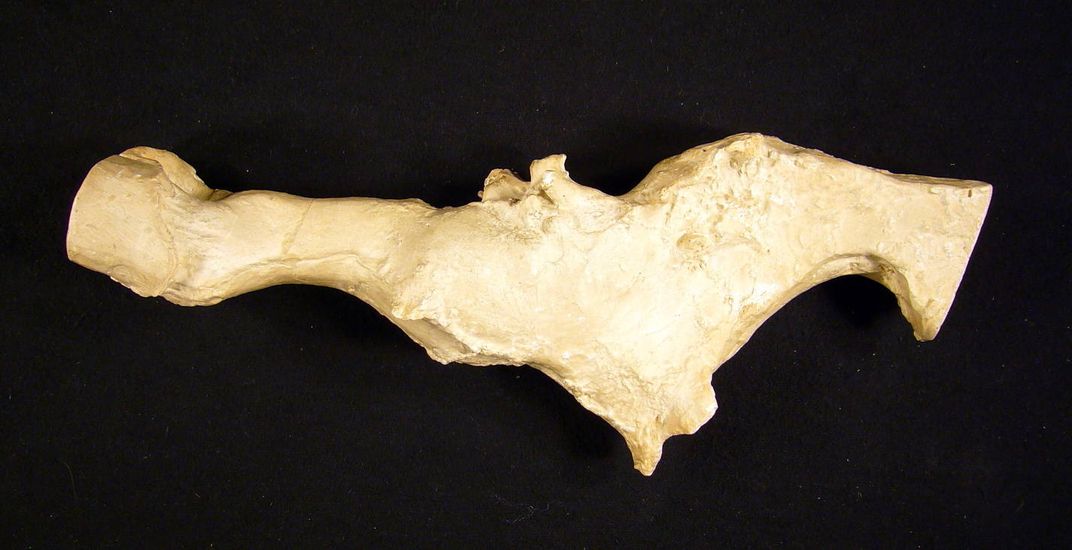The Woman Who Shaped the Study of Fossil Brains
By drawing out hidden connections, Tilly Edinger joined the fields of geology and neurology
/https://tf-cmsv2-smithsonianmag-media.s3.amazonaws.com/filer/ae/03/ae036f72-be68-407c-a1cb-3256c1803c89/brain.jpg)
Tilly Edinger was one of those rare people who knew exactly what she wanted to do. After reading Othenio Abel’s Principles of Vertebrate Paleontology, she had her calling: the study of ancient animals through their bones. She would go on to become one of the most significant paleontologists of the 20th century, and the first woman to be elected president of the Society of Vertebrate Paleontology. Not only that, but she would found an entirely new field of inquiry—paleoneurology, or the study of fossil brains.
Edinger once called the discovery of a petrified, brain-shaped lump of mud inside the cracked skull of a pterodactyl the “opening theme of the overture of paleoneurology.” Yet if this was the opening theme of paleoneurology, Edinger’s was the bridge that connected its disparate parts. By uncovering hidden connections no one else had seen, Edinger was able to piece together a budding discipline.
Edinger was born and raised in the city of Frankfurt am Main in 1897, to wealthy and well-known Jewish parents: social activist Anna Goldschmidt and prominent comparative neurologist Ludwig Edinger, founder of the Neurological Institute at the Goethe Institute and the first Chair of Neurology at the University of Frankfurt. The young Edinger received a high-quality education, first at home at the hands of a governess and then at the only girls’ school in Frankfurt, the Schiller-Schule.
But after high school, it was expected that Edinger would marry rather than follow a profession. Her mother would continue to refer to Edinger’s work as a “hobby,” even after it was clear that Edinger was going to pursue a career in science when she embarked on her doctoral studies.
Despite social convention, Edinger went on to study at the University of Heidelberg and Munich and later earn a doctoral degree in geology, zoology and psychology from Frankfurt University in 1921. For her dissertation research, Edinger studied an endocast of the Triassic marine reptile Nothosaurus, kicking off her life-long investigation into fossilized brains.
Soon after graduation, Edinger took on unpaid assistant positions at both the Geological Institute of Frankfurt University and the Senckenberg Museum of Natural history, which gave her access to vast collections of vertebrate fossils. She would be named Curator of Fossil Vertebrates at the Senckenberg in 1926. Around 1923, in a letter to Dutch anatomist C. U. Ariëns Kappers, Edinger writes: “I have noticed that a large literature exists about [fossil “brains”], distributed widely in all the journals of the earth, and I have given myself the assignment not only to collect but also to rework this material into a book, ‘Paleoneurology.’”

In 1929, Edinger published her nearly decade-long research project, Die fossilen Gehirne or Fossil Brains. “She had the biology and the geology background to start putting these specimens into a beginning context,” says paleontologist Emily Buchholtz, who has authored several profiles of Edinger’s life and scientific work with co-author Ernst-August Seyfarth. In her book, Edinger examined 280 papers that dealt with the brains and spinal cords of extinct vertebrates separately, but had not yet been looked at in relation to each other. Her achievement was to synthesize this work through the framework of two seemingly disparate fields: geology and neurology.
Before her, paleoneurology was largely descriptive, based on the random collection and characterization of specimens. In her examination of a century’s worth of research, Edigner saw connections that no one else had noticed. She used these observations to establish, an idea that shaped the burgeoning field. As Buchholtz writes, Edinger had transformed paleoneurology “into a discipline that was taxonomically, chronologically, and functionally informed.”
A year after the publication of Fossil Brains, the Nazi Party gained unprecedented power and became the second largest political party in Germany. By 1933, Adolf Hitler was named Chancellor. Hitler swiftly began passing oppressive legislation against Jewish people, starting with the Law for the Restoration of the Professional Civil Service Act. This act kept Jews and other so-called non-Aryans (as well as political opponents) from holding jobs in government institutions.
Since the Senckenberg was a private institution, Edinger was able to retain her position as curator. But this did not wholly shield her from the threat of Nazi violence, which shaped her daily life and work. For five more years, she would strive to make herself as invisible as possible by entering through the side door of the museum, removing her name plate from her door, and staying out of sight.

She faced another challenge, too. Since her teen years, Edinger had slowly been going deaf from otosclerosis, a disease of the inner ear. Though her disability did not typically hinder her work, she was forced to stop attending professional meetings, which required her sit in the front of the room to hear the speaker. This drew unwanted attention: Jewish people with disabilities, like Edinger, were at an even higher risk of violence and sometimes sterilization under the 1933 Law for the Prevention of Progeny with Hereditary Diseases.
Yet despite the urging of her colleagues and friends, Edinger refused to leave Frankfurt. When Harvard physician and family friend of the Edingers’ Alice Hamilton visited in 1938, she recalled Edinger saying, “... Frankfurt is my home, my mother’s family has been here since 1560, I was born in this house. And I promise you they will never get me into a concentration camp. I always carry with me a fatal dose of veronal.”
On November 9, her resolve shifted. That night—which came to be called Kristallnacht, or the Night of Broken Glass—marked a frenzy of destruction in which Nazis systematically burned synagogues, destroyed Jewish businesses, homes, and institutions, and murdered and imprisoned Jewish people across the Reich. Edinger was left with little choice but to seek her escape.
Even with the knowledge of the heightening Nazi brutality, the U.S. continued to comply with the Immigration Act of 1924, which limited immigration to 150,000 immigrants per year. Edinger was given quota number 13,814. The Act allowed foreign ministers and professors to bypass the quota if they could find work in an American institutions, so Edinger’s colleagues in Europe and the U.S. rushed to help her secure a position. George Gaylord Simpson wrote to the American consulate praising Edinger as a “research scientist of the first rank … She is so preeminent in this field that she may really be said to have created a new branch of science, that of paleo-neurology.”
Still, Edinger was not approved. As she awaited her quota number to be called, the Emergency Association of German Scientists Abroad helped her obtain passage out of Germany to London. Having lost nearly all of her family’s estate in the Holocaust, she took with her only two German marks and a set of cutlery. Finally, in 1940, Edinger’s number was called, and she was able to find work as a research associate at the Harvard Museum of Comparative Zoology (MCZ) with the help of Emergency Committee in Aid of Displaced Scholars. She was one of the only four women scientists granted aid by the Committee.
“One way or another, the fossil vertebrates will save me,” Edinger had written, in an eerily prescient letter to a colleague in 1938. She was right: “That book did in fact save her life,” Buchholtz says, referring to Fossil Brains.
This is little exaggeration. Back in Germany, Edinger’s brother, Fritz, died in a concentration camp. The Nazis removed the street sign, Edingerstrasse, named after Ludwig, along with a bust of her mother, Anna, from a city park. With not much left in her home country, Edinger had decided to stay in the U.S. after she received news that her aunt had died in 1943. “My last tie with anybody in Germany ended … when I was informed … that my father’s sister in Berlin, the woman I loved best in the world committed suicide when she was deported,” Endinger wrote in a letter to paleontologist Sir Arthur Smith. She made it to Boston, and became a citizen in 1945.
At the MCZ, Edinger returned to her work in paleoneurology, turning her attention now to the horse brain. When Edinger began this particular study, many understood the evolution of the brain within one timeframe. Edinger, however, charted the horse brain over different geological time periods, finding that brain enlargement and folds on the surface of brain arose independently from and in parallel to different mammals. Buchholtz says that “[w]hat Edinger was able to do, was to actually know where in the fossil record these different shapes of brain of one particular species occurred.” In 1948 Edinger published the culmination of this research in her second monograph, Evolution of the Horse Brain.
On May 26, 1967, Edinger was struck by a truck while crossing the street, an accident widely attributed toher hearing loss. She died at Cambridge City Hospital the next day. Up until her sudden death, even after her 1964 retirement from the MCZ, Edinger continued her own research and remained active in the paleontology community.
Although her career was punctuated by many traumas and upheavals, Edinger published nearly 100 articles and books. Moreover, in laying the groundwork for modern paleoneurology, she expanded the possibilities of how fossilized brains could inform our understanding of an evolutionary past. After her death, colleagues completed her unfinished project of 20 years, an annotated bibliography of paleoneurology that chronicled the field from its beginning in 1804 to 1966. It still serves as an entry point into the discipline.